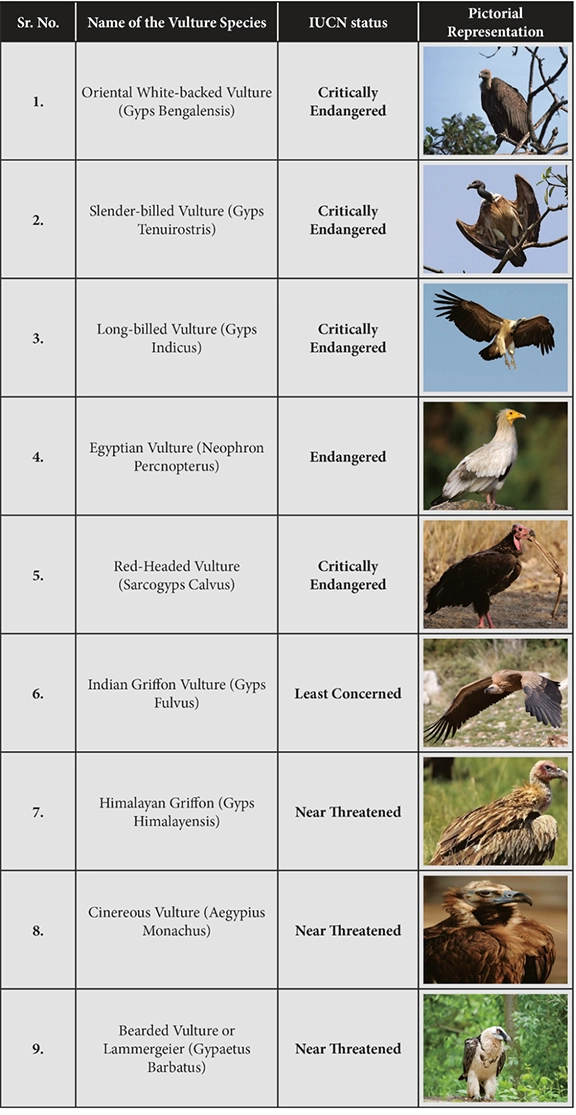Important Facts For Prelims
Synchronised Survey of Vultures
- 15 Mar 2023
- 4 min read
Why in News?
There are 246 vultures spread across Tamil Nadu, Karnataka and Kerala, according to the first-ever synchronised census on the bird carried out in February 2023.
- The survey was conducted by the Kerala Forest and Wildlife department along with its counterparts in Tamil Nadu and Karnataka in the select regions of the Western Ghats.
What are the Key Highlights of the Survey?
- The survey was carried out in the Mudumalai Tiger Reserve (MTR) and the adjoining landscape consisting of Sathyamangalam Tiger Reserve (STR) in Tamil Nadu, Wayanad Wildlife Sanctuary (WWS) in Kerala, Bandipur Tiger Reserve (BTR) and Nagerhole Tiger Reserve (NTR) in Karnataka.
- A total of 98 vultures were seen in MTR, two in STR, 52 in WWS, 73 in BTR, and 23 in NTR.
- Volunteers sighted White-rumped vultures (183), Long-billed vultures (30), Red-headed vultures (28), Egyptian vultures (3), Himalayan Griffon (1), and Cinereous vultures (1).
- Vultures are witnessing a catastrophic decline from the 2000s as these species are being exposed to diclofenac drug which is mainly used as a painkiller for cattle and experts believe that increasing wild carcass availability was one of the major steps needed to help vultures thrive.
What are Vultures?
- About:
- It is one of the 22 species of large carrion-eating birds that live predominantly in the tropics and subtropics.
- They act an important function as nature’s garbage collectors and help to keep the environment clean of waste.
- Vultures also play a valuable role in keeping wildlife diseases in check.
- India is home to 9 species of Vulture namely the Oriental white-backed, Long-billed, Slender-billed, Himalayan, Red-headed, Egyptian, Bearded, Cinereous and the Eurasian Griffon.
- Most of these 9 species face dangers of extinction.
- Bearded, Long-billed, Slender-billed, Oriental white-backed are protected in the Schedule-1 of the Wildlife Protection Act 1972. Rest are protected under ‘Schedule IV’.
- Most of these 9 species face dangers of extinction.
- International Union for Conservation of Nature (IUCN):
- Threats:
- Loss of Natural Habitats due to anthropogenic activities.
- Food Dearth and Contaminated Food.
- Electrocution by Power lines.
- Conservation Efforts:
- Recently, the Ministry for Environment, Forests and Climate Change launched a Vulture Action Plan 2020-25 for the conservation of vultures in the country.
- It will ensure minimum use of Diclofenac and prevent the poisoning of the principal food of vultures, the cattle carcasses.
- To study the cause of deaths of vultures in India, a Vulture Care Centre (VCC) was set up at Pinjore, Haryana in 2001.
- Later in 2004, the VCC was upgraded to being the first Vulture Conservation and Breeding Centre (VCBC) in India.
- At present, there are nine Vulture Conservation and Breeding Centres (VCBC) in India, of which three are directly administered by the Bombay Natural History Society (BNHS).
- Recently, the Ministry for Environment, Forests and Climate Change launched a Vulture Action Plan 2020-25 for the conservation of vultures in the country.
UPSC Civil Services Examination, Previous Year Question (PYQ)
Q. Vultures which used to be very common in Indian countryside some years ago are rarely seen nowadays. This is attributed to (2012)
(a) the destruction of their nesting sites by new invasive species
(b) a drug used by cattle owners for treating their diseased cattle
(c) scarcity of food available to them
(d) a widespread, persistent and fatal disease among them.
Ans: (b)





